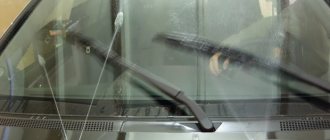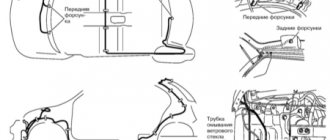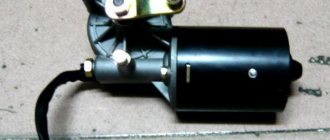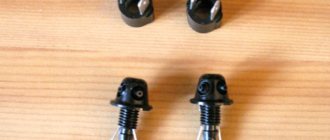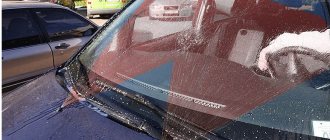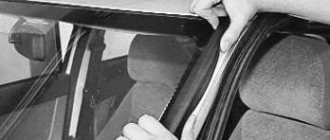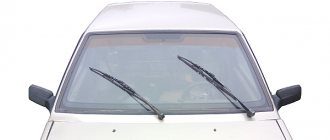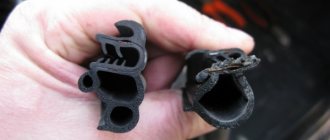The cleanliness of the windshield is one of the most important elements that determine the visibility of the roadway, and ultimately traffic safety. This is especially true in bad weather conditions or during mass accumulations of insects. Undoubtedly, the main task of cleaning the windshield is solved by wipers (wipers). At the same time, the efficiency of their work directly depends on the washer. If the liquid is well sprayed on the surface, the glass is cleaned faster, thereby providing the driver with the visibility necessary for safe driving. The quality of spraying of washer fluid onto the windshield depends on how efficiently the nozzles work. In this article we will look at how to replace windshield washer nozzles and which jets are best to choose for this.
Types of nozzles
Every car produced recently is equipped with fan-type jets. On cars of previous years, jet-type injectors were installed.
Jet washer nozzles. Such nozzles have the form of a sex cylinder. This design has a fitting at the bottom. Thanks to it, the nozzle is connected to the hose. There is a sprayer built into the top. The water supply force is adjusted using the existing screw.
Fan-shaped washer nozzles. When they work, a large area of glass is covered. Brushes instantly clean glass from various contaminants. The main feature of their design is the multitude of spray nozzles. Usually there are at least three spray nozzles in this type. In this case, the channel through which the liquid passes is of smaller diameter. Because of this, the liquid sprays out with greater pressure.
Features of fan nozzles
The right look is a modern solution for supplying water to the surface. Their main feature is that they cover almost the entire surface with washer fluid. Jet nozzles wash only certain areas with water.
The advantages of fan nozzles include the following:
- any contamination is removed faster due to complete coverage of the glass with water;
- wipers work on a wet surface immediately after operation;
- Thanks to the operating principle of this type, fluid is saved. Less consumption of anti-freeze in winter can significantly reduce your costs;
- Due to the instant supply of water, the likelihood of causing micro-scratches when moving the wipers is reduced.
On our website you will find a video test drive of the Haval H6, which promises to be excellent value for money.
How to choose universal fan windshield washer nozzles
The best option would be to purchase injectors that are designed specifically for your car brand. Nowadays, many manufacturers produce original injectors for a specific car. Universal nozzles are also available for sale. They can be installed on any car. But sometimes additional work may be required.
Good quality universal injectors are produced by Volvo and Sang Yong. In general, both products are identical, the only difference is in price. The cost of a Korean element is significantly lower than that of a Swedish one. Volvo injectors are considered to be more prestigious. They are installed on most Japanese cars. Also, as an option, you can consider injectors manufactured by Toyota. They are also unique and fit most vehicles. When replacing your original injectors with unique ones, in addition to the injectors themselves, you need to buy a tee with a hose and a check valve. To quickly fire the injectors after pressing the lever, you can install a check valve. Sometimes it happens that the manufacturer takes care of this right away.
Why buy a check valve?
The check valve is not a mandatory element of the washer system. When there is no pressure, the water from the nozzles will flow back into the barrel. After pressing again, the hoses will be filled with water and only after this delay the washer will work. The wipers work faster. They will work on a dry surface for a couple of seconds. If there is a check valve, water will not go into the barrel when there is no pressure. It will be located in the washer system. Thus, after turning on the washer, water will instantly splash across the glass. But its use also has its disadvantages. In severe frosts, water will freeze in the pipes. Installing heating of the tank and injectors will help solve this problem.
Nozzle selection
Today, most car owners use fan washer nozzles. Their advantage is that water does not fall onto the windshield in drops or in a couple of jets of liquid, but at once in a large number of small drops, thanks to which most of the glass is immediately covered. This is the main advantage of fan-type wipers, thanks to which the wipers begin to work on wet glass, carefully removing sediment or dirt.
Of course, this ensures the least risk of the wipers leaving scratches on the surface of the glass, since the sweeps will no longer occur on a dry surface. Many car owners also claim that using this type of nozzle reduces windshield washer fluid consumption. The only drawback is their unusual design, which is why they quickly freeze in the cold season, but in this case it is recommended to immediately select and install elements with a heating function.
There are recommendations that you need to choose original injectors, according to the make of your car. But these can be expensive and, in this case, you can choose non-original ones. The alternative will cost less, but some improvements are possible. The most common injectors, which are suitable for installation on many brands of cars, are from Volvo S80, and an even cheaper option is from SsangYong. Skoda fits perfectly on Daewoo Lanos and Chevrolet Aveo cars. Also, for example, elements from the Mitsubishi Galanta produced in 2008 are suitable for many car models.
Their standard configuration may not include a check valve. Thanks to it, liquid is prevented from flowing back into the washer reservoir if the suction pump does not work.
It is this valve that ensures a continuous supply of fluid. It has the shape of a spring-loaded ball and closes the hole in the nozzle if liquid is not supplied to the glass by the washer.
We recommend: Measuring compression in engine cylinders - a proven method for detecting faults with your own hands
In general, you can do without this valve, but then you will need to think of another way so that the wipers do not work before the water is supplied to the glass. Such a valve can also be selected from different cars, for example from VAZ 08 or 09, Toyota or Volvo.
The main reasons for washer failure and repair methods
There are three main points that may prevent fluid from flowing to the windshield.
The washer may not function due to a simple lack of liquid in the tank
1 reason. Forgetfulness or negligence of the driver himself
The washer may not function due to a simple lack of liquid in the reservoir. This problem can be solved simply: buy glass liquid and pour it into the tank. In most cars it is located under the hood, where exactly it is better to check in the technical documentation for servicing the vehicle. Each car brand has its own design solutions.
“Anti-freeze” is resistant to low temperatures, but each has its own freezing threshold
In winter, the washer may not work due to freezing of the liquid in the reservoir. For the winter it is better to fill in “anti-freeze”. It is resistant to low temperatures. Fixing this problem is also easy. It is enough to drive the car into a warm room for several hours or warm up the engine to operating temperature. The heat from the motor will melt the water. It is best to pump it out of the tank and fill it with winter washer.
Reason 2. Mechanical damage in the glass cleaning system
The main factors may be:
- disconnection or rupture of the tube through which liquid flows to the sprayers;
- the hose on the way from the tank to the injectors is pinched by other body parts;
- the reservoir is leaking; there may be a crack in it and washer fluid leaks through it;
- clogged nozzles.
Replacing injectors can eliminate technical problems
Mechanical problems can be resolved by replacing the hoses, reservoir or injectors on the hood. You can try to clean the latter with a thin needle. This type of repair of the windshield cleaning system is within the power of every car enthusiast.
Reason 3. Electrical fault
Such problems can be called the most complex, but some can also be fixed with your own hands, without going to a car service station.
Electrical failures can be as follows:
- system fuse has blown;
- poor contact on the connector of the pump that pumps liquid;
- failure of the electric motor in the pump.
Checking for faults in electrical circuits should begin with the fuse. According to the car's owner's manual, you need to find where the fuse box is located. On the back of the block there is a diagram of their location. Using it we find the required fuse, check it and, if necessary, replace it.
If everything is fine with the fuse and the washer does not work, go ahead and check the voltage at the electric pump connector. We disconnect the chip and use a voltmeter to check the presence of 12 volts when the washer button is on. The absence of voltage indicates that you need to look for a break in the wiring from the power button to the connector.
If after checking the wiring and contacts the washer does not work, then most likely the problem is in the motor itself. It should be replaced. The fluid supply pump fails rarely, but if it happens on the road, it will be difficult to carry out such repairs. In this situation, it is better to contact the nearest auto repair shop.
Accurate fault diagnosis
The first thing that comes to the mind of a car enthusiast who is faced with a washer failure on the road is cleaning the injectors with improvised means. The measure is justified when the nozzle is clogged with the naked eye - removing debris with a needle or pin will take literally a few minutes. But often the failure of nozzles is associated with other reasons:
- Malfunction of the electric pump, which does not pump up water when the button is pressed.
- Clogged supply pipes.
- A banal lack of liquid in the washer reservoir.
- Injector failure.
Before you start cleaning the jets, open the hood and make sure there is cleaning fluid. There are different situations: for example, the plastic tank is cracked, water leaks out, and the stain under the car is invisible due to rainy weather. A leak also occurs on the mounting flange of the electric pump.
If you do not hear the characteristic buzzing sound of the pump when you press the lever, immediately try replacing the fuse. Replacing the fuse link did not help - remove and repair the pumping device. Elements with a non-separable design have to be replaced with new ones.
It is not difficult to identify a tube clogged with dirt . Once you reach the bottom of the sprayer, remove the supply pipe, turn on the ignition and press the windshield washer button. If the electric pump hums and the water barely drips from the tube, it should be thoroughly cleaned and rinsed.
Washing with removal
In particularly advanced cases, nebulizers do not want to be cleaned using traditional methods - using needles, wires and syringes. There is only one option left - to remove the injectors from the car, wash them thoroughly, and if that fails, buy and install new parts.
On many modern cars, the sprayers are held in the holes by plastic clips. Dismantling is carried out in this order:
- Find a narrow flathead screwdriver in the garage.
- To remove the washer nozzle, use a screwdriver to pry the product at the bottom pad and pull it up.
- Pull the element out along with the pipe.
- Disconnect the handset. As a rule, it is pulled over the fitting without being secured with a clamp.
Immerse the removed element in a soap solution for a day or try treating it with a chemical detergent. Finally, blow out the nozzle with a pump or compressor and replace the nozzle in reverse order. Check where the jet hits and adjust the element if necessary. If the above manipulations do not lead to the desired result, simply replace the atomizer - the spare part is inexpensive.
https://youtube.com/watch?v=XFKr0spzyiE
The left driver's injector began to spray poorly. Now to the side, now up. I thought about changing it, but somehow the price is 750 rubles. I didn’t like the nozzle. I decided to try a long-proven method. Cleaning with citric acid. Due to the fact that most motorists do not pour distillate into barrels, during operation, limescale and other deposits form inside the washer nozzles, which over time prevent the free movement of the ball inside the nozzle, which is why the spray pattern “suffers.” Citric acid is very effectively removes limescale. And so. Take 1 pack of citric acid. Dilute 2-3 tablespoons of lemon in 100-150 ml of water. It is not difficult to check the correct concentration. If you pour a few drops onto the concrete, you should hear a hissing sound. Now remove the nozzle, make this device, put on rubber gloves and pour lemon juice through the nozzle.
To complete the effect, after 2-3 full syringes, I lightly pressed the syringe plunger so that the lemon flowed into the nozzle, but did not flow out through the sprayer, and left it in this state for 20-30 minutes. After this period of time, I poured another 2-3 times and there was already a result. The injector worked like it did from the factory. Uniform spray fan. Next, rinse the nozzle 1-2 times with plain water. I did the procedure with both injectors. That’s all. However, in my case it wasn’t all right. When I installed it, there was a fan a couple of times, and then the same thing again. The determination to buy a new one was maximum. However, I remembered that there is an L-shaped check valve under the nozzle. I decided to wash it in the same way. After washing and reassembling, the injector came to life and is still working to this day. But I had to make fun of the injector some more. While I was removing and installing it, one of the “whiskers” of the injector mount broke off. I used the Volver-XC90 method to solve this problem. I took an M8 thread and cut a thread onto which I screwed a nut.
This design now holds the injector better than the factory mustache. You just need to be careful when tightening and unscrewing the nut so as not to drop it into the hood.
How to clean windshield washer nozzles? Required instructions
High-quality visibility for the driver while driving is one of the most important conditions for driving safety. When the windshield is filled with dirt and rain, when insects stick to it, and in other situations, a washer saves you from contamination.
An important part of this cleaning system are the nozzles through which water is supplied to the glass. But often they do not spray water onto the surface well, this is not always a failure, it may simply be that something got into the water supply tube (washing fluid)
Sooner or later the time comes when the injectors fail and you need to replace them with new ones. But much more often they become clogged and you have to go to a service station or clean them yourself.
In the second case, you need to know how to properly clean the windshield washer nozzles.
How to fix watering on a VAZ
Suppose a breakdown occurred on a VAZ car. Let's talk first about the “tenth” family. To replace washer nozzles on a VAZ 2110, we will need the following tools:
- wrenches;
- screwdrivers.
Begin.
- First of all, we dismantle the air intake grille.
- Next, unscrew the fasteners and remove the decorative trim.
- Having unscrewed the screws securing the defective elements, we dismantle the latter.
- We pull out the ends of the tubes from the dismantled elements.
- We install new spare parts and reassemble in the reverse order.
If the spray nozzles are broken on the “twelfth” model, then we replace the defective windshield washers on the VAZ 2112 using exactly the same technology.
However, it happens that the pump of the washer fluid spray system breaks down (due to, say, turning on a system filled with water in subzero weather). Then, to replace the “dead” windshield washer motor, you will have to remove the battery, remove the system reservoir, disconnect the wires and reinstall the unit.
Now let's talk about Samara's family. To replace the injectors on a VAZ 2114, we’ll take some tools, namely pliers.
Everything is much simpler here. Let's get started.
- We open the hood and find our broken parts.
- We pull out the hoses from them.
- Gently squeezing the fasteners from below with pliers, we pull out the defective units.
- We install new ones in the reverse order.
And here’s how Kalina’s replacement goes. Only a screwdriver is taken from the tool. They start by opening the hood.
- Using a tool, pull out the clips securing the hood trim.
- Remove the casing.
- Remove the tubes from the broken jets.
- Remove the faulty elements and install new ones. Then everything is assembled on the way back.
Now as for Priora. To replace the washer nozzles from Priora, we take the following accessories:
- flat screwdriver;
- piece of fabric.
- Having placed a quadruple piece of fabric, we pry the defective element with a tool and pull it out from the hood hole.
- We remove the pipe from it.
- We install the new spare part in the reverse order.
However, the picture will be more detailed if we look at popular foreign cars.
What to do with foreign cars
To replace the windshield injectors on Renault Logan, we will need pliers. We act like this.
- We open the hood and find the defective element.
- Remove the flexible tube from it.
- Gently squeezing the clamps with pliers, pull the sprinkler out.
- We install the new spare part in the reverse order.
As you can see, for this car it is very easy to carry out the entire process with your own hands.
The situation is somewhat different with the Korean foreign car. To replace the windshield washer nozzle on a Kia Sid, you need to use a flat-head screwdriver. What are we doing.
- Carefully insert the tip of the tool from the front seats of the car under the jet. Then press the latch.
- We take out the broken part to ourselves.
- We disconnect the flexible tube from the dismantled element.
- We install the new sprayer, moving backwards step by step.
Here we mention that replacement is carried out in almost the same way at Solaris. You just need to use a screwdriver a little differently. More precisely, you need to take two screwdrivers. Use one to pry the jet from the side of the window, and the second from the inside of the hood.
But when changing the windshield washer nozzles on a Chevrolet Trailblazer, we proceed one by one as in the instructions just given.
It is much more difficult to replace the windshield washer nozzles on an Opel Astra. For this car, in order to get to the broken nozzles, you must first unfasten the wiper arms by removing the caps and unscrewing the nuts. And then you still need to dismantle the plastic panel on which the replacement fittings are attached. It won't be difficult to remove them from the panel.
Adjustment
Another important element of maintaining your car's windshield washer system is adjusting the nozzles. It is required if the jet coming out of the nozzle is directed in the wrong direction.
The process itself is simple and will take just a few minutes. And how to adjust? There is no need to remove or dismantle anything. Just do the following:
- take a regular needle or pin;
- insert it with a sharp edge into the nozzle (there are 2-3 nozzles in total);
- depending on where the jet is directed, start turning the needle in the required direction;
- if the jet goes above the glass, we turn it down, and if it sprays very low, we move up;
- left and right are adjusted in the same way.
Such manipulations are possible due to the fact that the sprayers themselves have the shape of a ball rotating inside a plastic housing. Therefore, a simple needle can act as an excellent adjustment tool.
https://youtube.com/watch?v=pKbYP9TI9NA
As you can see, cleaning and adjusting the windshield sprayers on your car is very simple. You just need to monitor their condition and carry out preventive measures on time. But if the injectors completely stop working, then you will have to spend from 60 to 600 rubles, depending on the car, and replace the old devices with new ones.
Read this article on how to choose windshield wiper blades.
Thank you for reading this far! So it was interesting and useful for you! Don't forget to subscribe! More new content awaits you ahead!
(3 ratings, average: 5.00 out of 5)
Subscribe to updates and receive articles by email!
We guarantee: no spam, only new articles once a week!
A clear and clean condition of the windshield is the key to clear control over the condition on the road. And in order to ensure such cleanliness, any car, including Renault Logan, cannot do without working windshield washer nozzles. It happens that over time these elements fail and there is a need to replace them. In this article we will tell you how to replace these devices quickly and correctly, as well as which injectors are best for you to install on your Renault Logan!
The video shows the installation of fan injectors on Renault Logan.
How to clean the nozzles and windshield washer:
1) Look under the hood and assess the degree of fullness of the washer fluid reservoir. If there is not enough fluid, add to the normal level.
2) Identify the clogged nozzle.
3) Take a can and attach a tube to it. Place the tube against the nozzle and start blowing through it. As soon as the liquid begins to bubble in the tank, stop the procedure.
4) Check if you have resolved the problem (use the windshield washer). In most cases everything will work normally.
5) No effect? Take a screwdriver and pliers and remove the tube from the nozzle. It is possible that the injector is broken and you should replace it. When going to a car store for a new part, do not forget to take the old one - it will serve as a sample so that you do not make a mistake when purchasing. Then put the purchased part in place and attach the tube to it. Repeat step 4.
6) Sometimes it happens that the whole problem is in the nozzle, but compressed air cannot remove the blockage. Then it will have to be eliminated mechanically - using a guitar string or a thin needle.
7) As a last resort, you can resort to blowing out the nozzle using your lungs. Remove it and wash it thoroughly with soap so that no windshield washer fluid remains in it. Next, take water into your mouth, press the nozzle firmly to your lips and blow water into it with all your might in the direction opposite to the one in which the liquid flows through it. Then rinse the nozzles directly. Repeat several times if desired. If successful, everything will work with incredible efficiency - like a new car.
If you liked the article, share it on social networks and leave comments!
This article was produced by our experienced team of editors and researchers, who reviewed it for accuracy and comprehensiveness.
Number of sources used in this article: 12. You will find a list of them at the bottom of the page.
wikiHow's content management team carefully monitors the work of its editors to ensure that every article meets our high quality standards.
Clogged windshield washer nozzles are a fairly common problem. Typically the source is car wax or varnish, which creates a blockage at the top of the injector, preventing fluid from spraying onto the windshield. Despite all the inconveniences, this problem is quite easy to fix. If you can’t clear the blockage, replacing the nozzle is also not difficult.
What in the washer can break?
If the windshield washers do not work, it means that a failure has occurred in one of the sections of the system described above. Let's look at what problems with the glass washer may be associated with.
Pump
The pump motor is the part of the washer system that wears out very quickly due to frequent operation.
Unfortunately, you can understand that something is wrong with this device only when water stops flowing to the nozzles. Otherwise, it does not show its malfunctions in any way.
Pump repair method:
Two common ailments can affect the motor:
If corrosion of this device is your case, do not worry. Experienced motorists can easily cope with it with a simple eraser.
But if this mechanism is erased or broken, it will have to be pulled out and replaced with a new one.
You can understand that the pump is the cause of the problem by the absence of a characteristic sound. If you press the washer lever and do not hear the usual buzzing sound, it means that the pump motor is not working.
Often windshield washer malfunctions are associated with the breakdown of this particular part. We'll tell you how to replace it a little later.
Blockage
Also, water may stop flowing to the nozzles due to blockage. The fact is that the tubes through which the liquid flows are very thin and the debris that accumulates in them can cause obstruction. To combat this defect, the system will have to be flushed and possibly purged.
Torn hoses
Another reason could be that the hoses have lost their integrity. If the tubes become leaky, water will not get from point A to point B, just like if it is clogged.
No current
And another common reason is lack of nutrition. Check that the pump and accumulator shafts are securely fastened. Perhaps the motor is simply not receiving energy.
There are also terminals on the motor that could have oxidized or fallen off. Check them out.
There is also a windshield washer fuse on the motor with a power of about ten amperes. If the pump motor fails, this fuse may need to be replaced.
If problems are discovered during the cold season, it is possible that the water in the tank has simply frozen. You can fix this with a hairdryer. And it’s better to immediately fill in the “anti-freeze”, because due to frequent expansion under pressure of water that has turned into ice, the plastic container may burst.
Causes of windshield washer malfunction
Before replacing the windshield washer with a new one, diagnose the old one. Find out exactly what the problem is.
Causes of windshield washer malfunction: - clogged nozzles; - hoses are in poor condition - cracked, torn, etc.; — the terminals came off; — electric pump malfunction; — the barrel itself is cracked and liquid is leaking.
If the car is parked in the cold for a long time, it happens that in severe frosts the electric windshield washer pump freezes. By the way, if your pads are frozen, I can help you with advice here. Try warming it up. You need to put the car in the garage, drain the liquid and fill it with hot water and let it sit for a while, then drain the water and fill it with hot water again. After this, add glass washing liquid and check the operation. If the windshield washer does not work, then the motor has broken down and the windshield washer will have to be replaced.
Replacement is very simple and quick. You can carry out the replacement yourself, with your own hands, without using any tools (except for wrenches).
If you need to replace a new barrel, you need to decide what size it will be. If you forget to keep an eye on the windshield washer barrel, then you need to buy a barrel of a larger displacement, you will have an additional volume of washer fluid and will have to fill it less often than usual.
There are barrels designed for one and two pumps; you choose based on the brand of the machine.
Cleaning the windshield washer nozzle
Washer nozzles are fairly simple devices, and their operating principle is based on pumping water from the washer barrel using a tube into the sprinklers, also known as nozzles. Based on this, we can conclude that if the jet is weak, uneven, incomplete or incorrectly directed, the nozzles or tube clogged with dirt should be blamed.
Cleaning the washer nozzle if the nozzle is clogged
- Using compressed air. In the field of repair and maintenance of computer equipment, compressed air cans are often used, which are sold complete with nozzles of various thicknesses and lengths. To clean the washer nozzles, you need to buy a can of compressed air and use it. To do this, put on a nozzle of minimal thickness, press it firmly against the clogged nozzle and make several short (2-3 seconds) presses on the spray bottle. If you hear water starting to bubble in the washer barrel, you can stop the cleaning procedure - the nozzle is clean.
- Using improvised means. The second method of cleaning the washer nozzle can be considered budget-friendly. To clean the washer nozzle when clogged, if the problem is in the nozzle, just take a thin needle, wire, pin or guitar string. Using your chosen accessory, begin to gently clean the inside of the nozzle. This method helps much less often than the option using liquid air, since it will be difficult to remove “inconveniently” stuck elements of contamination.
Cleaning the washer nozzle if the tube is clogged
Before you start cleaning the washer tube from accumulated dirt, you need to gain access to its end that fits the nozzle. To do this, lift the hood and find the place where the tube connects to the nozzle. Unplug it, in most cases a screwdriver and pliers are enough to do this, and then you can start cleaning.
There are two surefire ways to clean windshield washer transmission tubes:
- Using compressed air. As with cleaning the nozzle, compressed air in a can is ideal for cleaning the tube. The cleaning process is simple: select a nozzle for the cylinder to match the diameter of the tube, it is pressed as tightly as possible to the end of the tube, after which a stream of air is supplied. When the air begins to flow without any problems, it can be stated that the windshield washer tube has been cleaned.
- By blowing out the tube yourself. Before you start purging the tube, be sure to rinse it thoroughly several times in soapy water. After this, touch the end of the tube with your lips, squeeze them as much as possible and blow a stream of air into the tube. Despite its simplicity and obviousness, this method is effective and cheap.
It is strongly recommended that after cleaning the windshield washer nozzle, remove the washer reservoir and completely replace the fluid in it, after first rinsing it well several times. The cause of frequent clogged washer nozzles, in most cases, is accumulated dirt in the washer fluid reservoir.
How I clean the washer nozzles from limescale plugs myself
Much more often, they simply become clogged, which leads to the need to visit a service station or clean them yourself. If the choice is made in favor of the second case, then you should know how to properly clean the windshield washer nozzles.
Cleaning methods
Now about how to clean the windshield washer nozzles. There are many methods that were invented by folk craftsmen. They are effective and easy to implement.
I'll tell you several methods. And you decide for yourself which path to take.
- Application of a compressor. It is considered the most useful and fastest cleaning method. But you will definitely need the compressor itself. It’s not worth buying it just to clean the device. The compressor hose is connected to the nozzle nozzle and the air supply is turned on. Literally 30 seconds is enough to blow out all the dirt.
- An ordinary medical syringe. It is inferior in efficiency to a compressor, but consumables and tools cost pennies. Water with a small amount of citric acid is poured into the syringe. All hoses from the nozzle are disconnected. It is better to read in advance in the operating manual of your car how to remove the sprayer on it. A special feature of the method is that the syringe is inserted where the water comes out and does not enter. That is, on the back side of the nozzle. This will make washing more effective.
- A simple pin. Some people believe that you should not use pins and needles, since they can damage the glass washer spray. Well I do not know. I have used this technique many times and have had no problems. The main thing here is to be careful. Please note that pins only remove minor dirt. This is a kind of road method when you don’t have a compressor or at least a syringe with citric acid at hand. A pin or needle is inserted into the nozzle and the dirt is carefully picked out. Only those contaminants that have accumulated near the nozzle are cleaned. There's no point in going deeper.
- Detergent and cleaning agent. The method is effective, but will require quite a lot of time when compared with other methods. Remove the nozzle and place it in a container with water and cleaning agent. Sometimes it is enough to hold the sprayer there for a few minutes. But after that you still have to wash it. With a syringe or a compressor, decide for yourself.
As you can see, there are no particular problems with cleaning windshield washer nozzles. The procedure is simple, regardless of the method you choose.
Keep in mind that cleaning is not a panacea. In some cases, the injectors may wear out and permanently fail. Then the only way out will be to completely replace them. Well, at least they cost a little.
What types of malfunctions are there?
In fact, there are not so many problems, and they are divided into electrical and mechanical. Most often, problems arise in the mechanical part. Mechanical problems are simple, the first problem is lack of fluid. That is, it either simply ran out in the tank, or froze due to the low temperature. In the first case, you just need to top it up, and in the second, warm up the engine well, and its heat will defrost the liquid.
The hose could also have come off; it needs to be installed back, and the problem is solved. And the most common problem is clogged injectors. They can become clogged due to the use of low-quality fluid or due to the ingress of dust and weight.
Poor flow can also be due to problems with the pump or seals, so you should find out what the problem is.
Recommendations
Comments 41
Valeo C56 Compact 550 mm windshield wipers with fan washer nozzles for VAZ Priora Supplied from Volvo.
Awesome thing compared to ours! I've been traveling with fans for 5 years now. At speed on the highway it is inconvenient - it blows the spray down the windshield. The Land Cruiser has two-jet as stock, it hits the middle of the windshield even at 120 km/h. I want to try two-jet on a VAZ
Many people write about consumption, but this winter I spent less washer fluid with the fan ones than last winter with my family. I took the jets with the letter G, you can look in the bulletin board. The valve is from the previous owner, although there is an option that it was from the factory (the maximum configuration). True, one blows badly while driving, but I really liked it when I bought it, I’ll have to replace it in the spring.
In addition to all that has been said, I have a station wagon tank for two motors, I powered them together and each injector pumps its own motor.
This winter I installed one from a shnivy and one valve from Toyota, in front of the injectors, plus I soldered a resistor in the wiper relay to 50 kohm, the washer flows before the stroke, the brushes rub 2 times, the consumption is less than with the original ones
similar, only 3 years already)
They cost 600 rubles from a Volvo at one time, they pour beautifully with one press for 1 second. all the glass is filled. + there is a relay from VW, i.e. one press the glass is filled and 1 stroke of the brushes, and not 3 dry)
Can I have the relay number? I have 2 strokes and the second one is dry, when the brushes are new.
relay 99 article number 357955531 Soon I will make a post about the washer. My config: Washer reservoir drain + boiler from Mercedes w220 www.drive2.ru/l/466024980849624275/ Washer motors Golf www.drive2.ru/l/460725884559559225/ Check valve Toyota Fan injectors Volvo Windshield wiper motor VW Golf www.drive2.ru/ l/10119682/ Well, relay 99.
the original relay for disassembly costs 500-1000 rubles, and you get a super convenient relay, in addition to the washer, which is based on the turn-on time. The pause can also be adjusted very conveniently; the longer it is turned on, the longer the pause will be. or one revolution faster. in pause mode the brushes can clean quickly almost like in mode 1
I installed it from a VAZ 2101 on the hood, and there is no need to attach it to the frill like the tenth ones. But the effect is the same. I didn’t think about the consumption, the goal was to irrigate all the glass.
Many people also praise Chevy Niva
no one has ever put it! what you?!
Installed a long time ago - everything is fine, still alive. Washer consumption is much lower www.drive2.ru/l/7476703/
from 10k on a frill (there is a (welcom) in the BZ and the hood is always dry and clean))
Yes, the main thing is to install the valve
So the expense is still huge?
Without a valve, it will not be possible to irrigate in one second, so the flow rate will be higher. Plus with the valve it’s much more comfortable
Where should I install the valve?
Hyundai, Toyota... I got it from the same place on the market
If you want a fan
A new type of washer nozzles is rapidly gaining popularity. And this is understandable: compared to conventional jet nozzles, fan nozzles provide several advantages:
- The liquid is sprayed on the windshield more evenly, so that the brushes even make the first movement on the wet glass, reducing the appearance of scratches;
- The same uniformity ensures more complete removal of solid particles;
- Washer fluid is consumed more economically;
- Manufacturers have developed personal fan injectors for almost all modern models. However, if it is not possible to order them or they personally do not produce them for yours, you can choose a suitable one from another brand;
- The fan injector from Volvo under catalog number 30655605 is considered universal. It fits almost all models produced by Daewoo and Opel, and can be installed on Mitsubishi Colt and Subaru Forester;
- Mazda 3 and Mazda 6 are equipped with injectors also from Volvo, but no. 30655606;
- Injectors from VW-Skoda are perfect for Lanos, catalog number 3b0955985
; - For almost the entire Mitsubishi model range, injectors from the “American” Galant (2008 model year) are suitable. They cannot be installed on Grandis, Pajero Sport, Pajero 4, Outlander XL - the tilt angle cannot be adjusted in any way;
- injectors are perfect for Lexus GX 470, Pajero and Toyota LandCruiser Prado 120 crossovers .
When planning to install fan nozzles, remember that they are especially vulnerable in cold weather - they freeze much faster than jet nozzles, so it is better to order them heated. If the hood on your car has a sharp angle, when installing the nozzles you need to adjust the spray direction by placing a seal under their rear part. Another option is to heat the washer reservoir.
Fan windshield washer nozzles for Kia Rio-3
Fan injectors from Hyundai Solaris (Accent) with catalog numbers are suitable for Kia Rio-3:
- 98630-1R800 (right injector).
- 98630-1R100 (left injector).
- The check valve that fits has the spare parts catalog number - 98886-29000.
Tool
- 14mm wrench for removing windshield wipers.
- Two flat-blade screwdrivers (one thinner, the other regular).
- Knife (may be needed for cutting pipes).
- Double-sided tape (needed for gluing foam buffers, they will be discussed below).
Procedure for installing fan nozzles
The whole procedure includes: dismantling old injectors and installing new ones. We suggest dismantling the standard injectors carefully by removing the front plastic cover in which they are installed. To do this you will have to remove:
- Windshield wiper arms (use a screwdriver and a 14 mm wrench).
- Peel off the foam buffers on both sides (hold on with double-sided tape).
Carefully remove the central cover, in which the nozzles are installed and the water supply pipes run through.
To remove the nozzle, disconnect the tube, squeeze the antennae and push it out.
- Install a new fan nozzle.
- Replace the other injector in the same way.
- On the right side, where water is supplied from the tank to the nozzles, install a check valve. Remember that the arrow on it should point in the direction of water movement - from the tank to the nozzles.
- Reassemble and install all removed panels in reverse order.
There is also an easier way to replace washer nozzles, but there is a possibility of breaking the old (standard) nozzles during dismantling. The whole procedure consists of “picking out” the standard injectors with a screwdriver. In the next video, the master does it quite accurately, but this does not mean that it will happen for everyone.
That's what science is all about!
How often a car enthusiast cannot even go on a trip in his car if the driver's view washer suddenly stops working. And it would be fine if the liquid ran out, or the channels were simply clogged. It’s worse when the “sprinklers” themselves fail.
Here we need to replace the windshield washer nozzles. Fortunately, these sprinklers can be purchased quite inexpensively. But why do they become unusable? There are several reasons for this, we list them below:
- constant blockages lead to irremovable adhesion of dirt in the holes;
- temperature changes and constant humidity, which causes the holes to fill with rust;
- freezing water can cause cracking.
Of course, if you suspect any malfunction of these components, you should definitely try to clean them first. To do this, you can take a needle from a syringe and carefully insert it into the hole in the part, where the liquid sprays out.
In the case when the engine pumps washer fluid to the nozzles, and it splashes somewhere under the hood, that is, there is a rupture in the hose - in this case, the leaky washer hose must be replaced.
If, when removing the hoses from the sprinklers, liquid is supplied from each end of the hose, then there is only one thing left - to replace the nozzles that are not spraying. We will now study how it is produced. Also see how to replace a rear window washer nozzle and repair chips on the windshield.
How the windshield washer works
The windshield washer system in a car is part of the windshield wiper. With its help, liquid is sprayed onto the windshield, which allows you to better clean it from dirt while driving.
Glass washer device
The design of a modern windshield washer includes the following components:
- tank—container for washer fluid (coolant);
- coolant level sensor in the tank, if provided;
- connecting tubes;
- an electric pump that supplies coolant under pressure to the injectors;
- windshield washer nozzles mounted on the hood, as well as a rear window washer nozzle;
- switch.
To activate the windshield washer system, the driver must press the steering column switch. After this, the pump will turn on and coolant will be sprayed under pressure onto the windshield. At the same time, the wipers start working (video author - Anton AUTO).
Installation of fan washer nozzles
Installing fan washer nozzles instead of standard jet ones usually does not cause any particular difficulties. Depending on the car model, injectors can be installed either without additional modifications or with some nuances associated, for example, with adjusting the height of the injectors. On some vehicles the spray area may be very high. You can solve this problem by placing a sealant or two or three layers of electrical tape under the back of the nozzle. Sometimes the lower part of the body of fan nozzles turns out to be slightly wider than the previously installed jet counterparts. in this case, you will have to sharpen the body a little so that the nozzle fits into place.
Heating of injectors
Heating the washer jets is very important at low temperatures. There are several ways to implement injector heating.
Using SOD . This option is most suitable for those cars in which the injectors are installed on the grilles of the air intake system (jabot). For modification, it is necessary to prepare a copper tube and a heat-resistant radiator hose.
First, disconnect the steam exhaust hose of the heating system from the expansion tank. We connect the expansion tank hose to one end of the copper tube, and put on a new steam outlet tube to the other. We remove the air intake grille and make cutouts at the bottom for the steam exhaust tube. Then we put the frill in its regular place and mount the hoses. We install copper heat exchangers directly under the nozzles.
Using resistors . To electrically heat the injectors, it is necessary to mount two 0.75 W heating elements based on 150 or 200 Ohm chip resistors. The first resistors should be connected in series, and the second (1206) should be connected in parallel. In the nozzle body we make a hole for the heating element 5.0 mm wide and 1.0 mm deep. The heating elements of both injectors are connected in series.
They can be connected to the heated rear window button or output power through a separate button.
Cleaning methods
Now about how to clean the windshield washer nozzles. There are many methods that were invented by folk craftsmen. They are effective and easy to implement.
I'll tell you several methods. And you decide for yourself which path to take.
- Application of a compressor. It is considered the most useful and fastest cleaning method. But you will definitely need the compressor itself. It’s not worth buying it just to clean the device. The compressor hose is connected to the nozzle nozzle and the air supply is turned on. Literally 30 seconds is enough to blow out all the dirt.
- An ordinary medical syringe. It is inferior in efficiency to a compressor, but consumables and tools cost pennies. Water with a small amount of citric acid is poured into the syringe. All hoses from the nozzle are disconnected. It is better to read in advance in the operating manual of your car how to remove the sprayer on it. A special feature of the method is that the syringe is inserted where the water comes out and does not enter. That is, on the back side of the nozzle. This will make washing more effective.
- A simple pin. Some people believe that you should not use pins and needles, since they can damage the glass washer spray. Well I do not know. I have used this technique many times and have had no problems. The main thing here is to be careful. Please note that pins only remove minor dirt. This is a kind of road method when you don’t have a compressor or at least a syringe with citric acid at hand. A pin or needle is inserted into the nozzle and the dirt is carefully picked out. Only those contaminants that have accumulated near the nozzle are cleaned. There's no point in going deeper.
- Detergent and cleaning agent. The method is effective, but will require quite a lot of time when compared with other methods. Remove the nozzle and place it in a container with water and cleaning agent. Sometimes it is enough to hold the sprayer there for a few minutes. But after that you still have to wash it. With a syringe or a compressor, decide for yourself.
As you can see, there are no particular problems with cleaning windshield washer nozzles. The procedure is simple, regardless of the method you choose.
Keep in mind that cleaning is not a panacea. In some cases, the injectors may wear out and permanently fail. Then the only way out will be to completely replace them. Well, at least they cost a little.
What types of malfunctions are there?
In fact, there are not so many problems, and they are divided into electrical and mechanical. Most often, problems arise in the mechanical part. Mechanical problems are simple, the first problem is lack of fluid. That is, it either simply ran out in the tank, or froze due to the low temperature. In the first case, you just need to top it up, and in the second, warm up the engine well, and its heat will defrost the liquid.
The hose could also have come off; it needs to be installed back, and the problem is solved. And the most common problem is clogged injectors. They can become clogged due to the use of low-quality fluid or due to the ingress of dust and weight.
Poor flow can also be due to problems with the pump or seals, so you should find out what the problem is.
